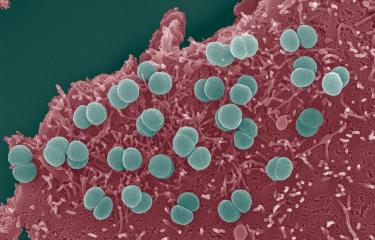The Inserm team led by Guillaume Duménil at the Institut Pasteur, in collaboration with several teams of physicists, has unraveled a key stage in infection by Neisseria meningitidis, a human pathogen responsible for meningitis in infants and young adults. Bacterial aggregates in blood vessels appear to facilitate the progression of the disease. Even if treatment is administered rapidly, the mortality rate due to meningococcal infections remains very high.
Human meningococcal meningitis (page in French) is characterized by a bacterial accumulation in blood vessels, which completely fill up with bacteria. But the mechanisms that govern the formation of these aggregates and the impact of the process are still unknown. A consortium of scientists, intrigued by this formation of intravascular aggregates, set out to understand this stage of infection, especially its underlying physical basis. Their findings revealed that "the bacterial aggregates formed by Neisseria meningitidis unexpectedly behave like a thick liquid, with a consistency similar to that of honey," explains Guillaume Duménil, Head of the Pathogenesis of Vascular Infections Unit. "The bacteria multiply rapidly in blood vessels, forming aggregates which gradually adapt to the complex geometry of the vascular network, like a flowing liquid." The scientists' research shows that the formation of these aggregates and their viscous properties are vital for the progression of the infection. A bacterial mutant that forms solid rather than liquid aggregates is at a considerable disadvantage in colonizing blood vessels.
A viscous liquid with original properties
The thick liquid nature of the aggregates depends on a virulence factor known as type IV pili. These long filaments, which have adhesive and dynamic properties, are constantly extending and retracting at the bacterial surface. The bacteria use type IV pili to find other bacteria, draw them in and temporarily establish contact. Aggregation is therefore based on an intermittent process of attraction between bacteria; in other words a constant alternation between the presence and absence of attraction. In physical terms, this intermittent process of interaction gives the aggregates original properties that had not previously been described. For example, bacteria inside aggregates exhibit a higher level of motility than that observed in the diffusion of isolated bacteria. "As well as improving our understanding of a lethal human infection, our research reveals a new type of active matter – a bacterial aggregate with a viscous, honey-like consistency – based on the intermittent attractive forces between its component parts," concludes Guillaume Duménil.
This multidisciplinary study was the result of close collaboration between a laboratory specializing in meningococcal infections (Guillaume Duménil, Institut Pasteur and Inserm) and physicists. By working with the teams led by Nelly Henry (CNRS, UPMC), Raphael Voituriez (CNRS, UPMC) and Hugues Chaté (CEA, CNRS, Paris-Saclay University), the researchers were able to combine a quantitative experimental approach with a physics-based model of active matter.
Source
Intermittent Pili-Mediated Forces Fluidize Neisseria meningitidis Aggregates Promoting Vascular Colonization, Cell, May 15, 2018.
Daria Bonazzi1,8, Valentina Lo Schiavo1,8, Silke Machata1, Ilyas Djafer-Cherif2, Pierre Nivoit1, Valeria Manriquez1, Hirokazu Tanimoto3, Julien Husson4, Nelly Henry5, Hugues Chaté2,6,7, Raphael Voituriez5,7, Guillaume Duménil1,9.
1. Pathogenesis of Vascular Infections Unit, INSERM, Institut Pasteur, 75015 Paris, France
2. Service de Physique de l’Etat Condensé, CEA, CNRS, Université Paris-Saclay, 91191 Gif-sur-Yvette, France
3. Institut Jacques Monod, 75013 Paris, France
4. Laboratoire d’Hydrodynamique (LadHyX), Department of Mechanics, Ecole Polytechnique-CNRS UMR7646, 91128 Palaiseau, France
5. Laboratoire Jean Perrin, CNRS UMR 3231, Université Pierre et Marie Curie, 75005 Paris, France
6. Computational Science Research Center, Beijing 100193, China
7. Laboratoire de Physique Théorique de la Matière Condensée, CNRS, Université Pierre et Marie Curie, 75005 Paris, France








